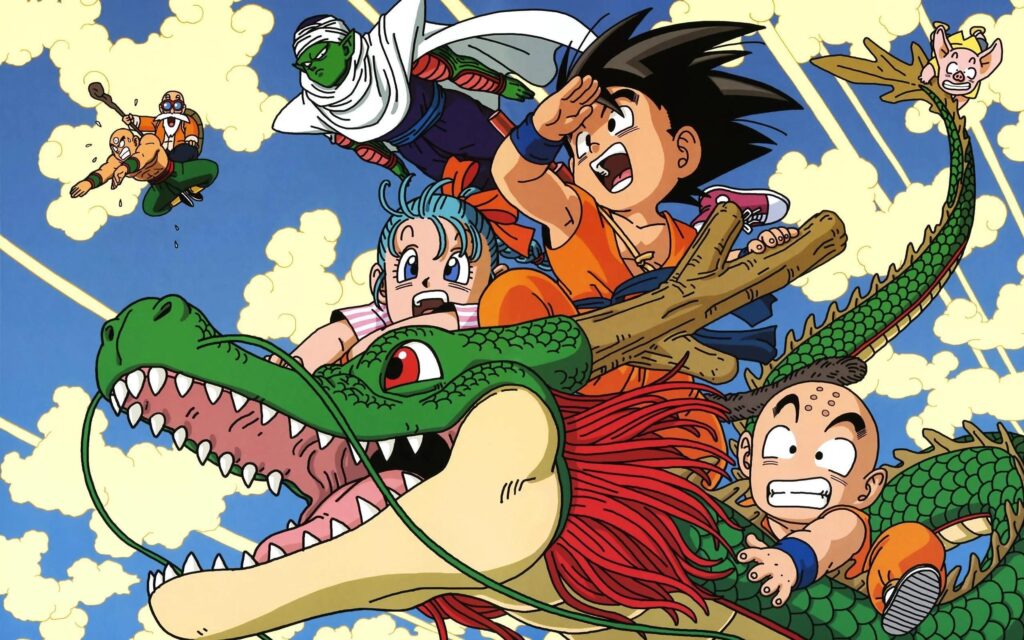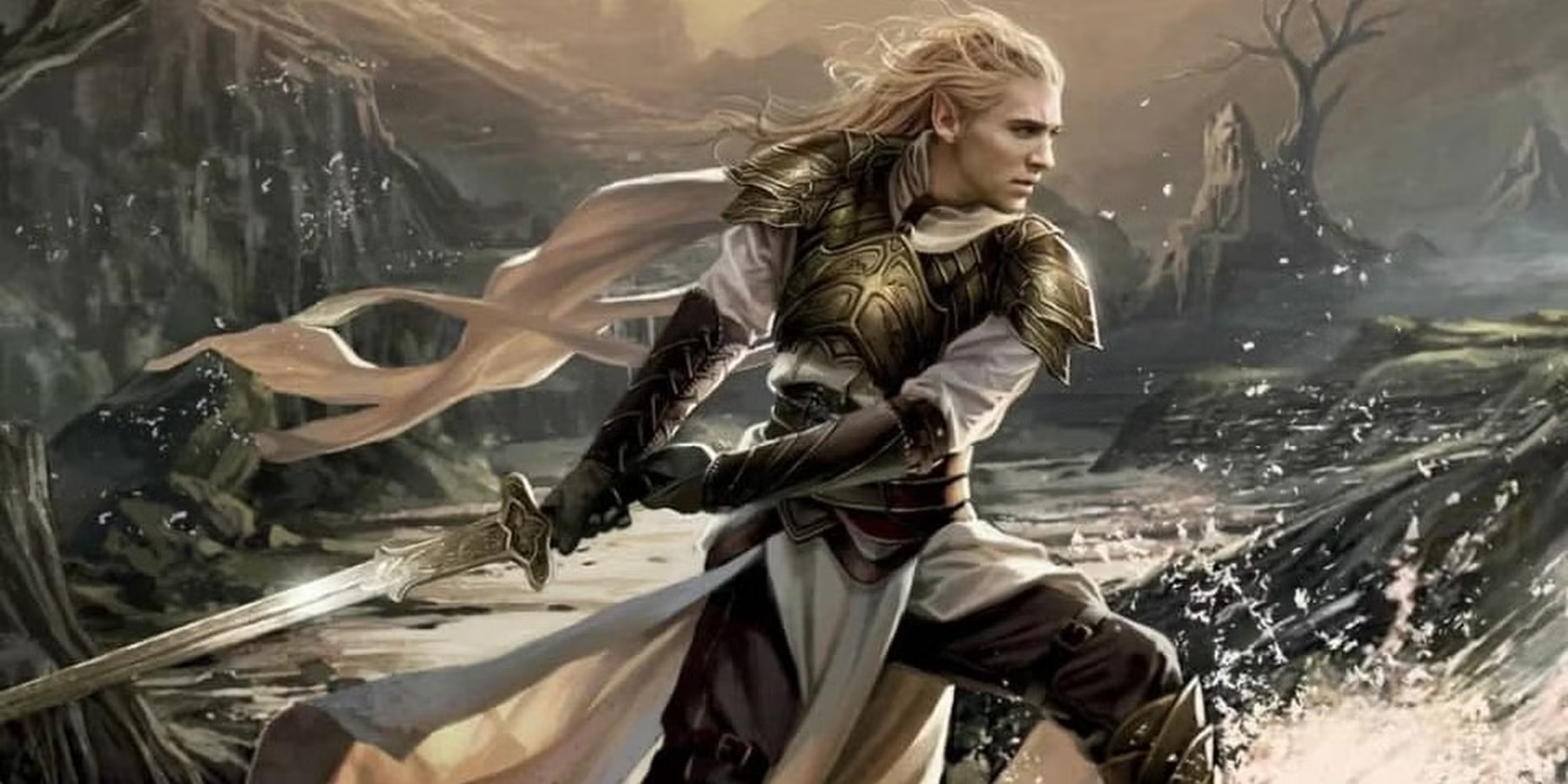Table of Contents
The Birth of a Legend
In 1984, Dragon Ball emerged as a groundbreaking manga created by Akira Toriyama and serialized in Weekly Shōnen Jump. Drawing inspiration from the classic Chinese novel Journey to the West and the dynamic action of martial arts films, Toriyama introduced the world to Son Goku, a young and naive martial artist with incredible strength and an enigmatic origin. The story follows Goku as he embarks on thrilling adventures to gather the seven mystical Dragon Balls, powerful artifacts that summon the wish-granting dragon, Shenron. Toriyama’s unique art style and storytelling, filled with humor, action, and heart, quickly captivated readers.
Dragon Ball didn’t just find fame in Japan; it became a global phenomenon, revolutionizing the way manga and anime were received worldwide. With over 260 million copies of the manga sold globally and the anime broadcast in more than 80 countries, the series established itself as a cornerstone of Japanese pop culture. Goku’s journey, from a curious boy to a powerful warrior, resonated with audiences of all ages, showcasing values of perseverance, friendship, and growth. By combining timeless themes with exhilarating battles and a richly imagined world, the series cemented its legacy as one of the most influential and beloved franchises in the history of entertainment.
Transition to Television: The Dragon Ball Anime
In 1986, Dragon Ball made its television debut through Toei Animation, bringing Akira Toriyama’s beloved manga to life. The anime followed the early adventures of Goku, focusing on his training under Master Roshi, his quest to gather the Dragon Balls, and his battles against the nefarious Red Ribbon Army. With 153 episodes, the series introduced fans to a vibrant cast of characters, including the brilliant Bulma, the brave Yamcha, and the loyal Krillin, each playing a crucial role in Goku’s journey. The anime’s mix of humor, heartfelt moments, and thrilling action sequences captured the spirit of the original manga, resonating with audiences across Japan and laying the foundation for its global appeal.
As the series progressed, Goku’s unwavering determination and growth as a martial artist became central themes that resonated with fans of all ages. Dragon Ball’s blend of comedic adventures and high-stakes battles made it more than just a children’s show; it became a cultural touchstone that inspired loyalty and nostalgia. By introducing viewers to a richly imagined world filled with mythical elements and dynamic characters, the anime solidified Dragon Ball as a cultural phenomenon. Its enduring popularity set the stage for subsequent installments that would elevate the franchise to legendary status in the world of anime and beyond.
Dragon Ball Z: The Rise of a New Era
In 1989, Dragon Ball Z marked a transformative chapter for the franchise, taking the action and stakes to unprecedented levels. Building on the foundation of its predecessor, the series shifted focus to Goku’s adult life and introduced viewers to the Saiyan race, revealing Goku’s alien origins. Early story arcs, such as the gripping battle against Vegeta and the Saiyan invasion, captivated audiences with their high-stakes confrontations. The shift toward intense action sequences and more complex character dynamics set Dragon Ball Z apart, establishing it as a trailblazer in shōnen anime. The introduction of power-ups, such as the legendary Super Saiyan transformation, redefined the franchise’s identity and became a cultural symbol of perseverance.
As the series progressed, Dragon Ball Z delved into sprawling sagas that spanned galaxies, like the iconic Frieza Saga, where the heroes battled on Namek against one of anime’s most memorable villains. The series expertly balanced its dramatic storytelling with themes of friendship, sacrifice, and growth, resonating with a global audience. The escalating power levels and emotionally charged moments, such as Goku’s transformation into a Super Saiyan, solidified the anime’s legendary status. By expanding the narrative and introducing unforgettable characters and arcs, Dragon Ball Z cemented its place as a cornerstone of anime history, captivating fans around the world.
The Expansion of the Universe
Dragon Ball Z introduced a broader, more intricate narrative by delving into Goku’s Saiyan heritage and revealing his extraterrestrial origins. This development expanded the universe of Dragon Ball, introducing the concept of the Saiyan race and their role in intergalactic conflict. Iconic characters like Piccolo, Vegeta, and Gohan experienced significant growth, with their personal struggles and transformations adding depth to the story. Vegeta’s journey from ruthless villain to reluctant ally and Gohan’s evolution into a formidable warrior highlighted themes of redemption, perseverance, and legacy. These character arcs, paired with dynamic battles, captured the attention of audiences and solidified the series as a cultural icon.
The Android and Cell sagas pushed the boundaries of Dragon Ball storytelling by incorporating complex themes such as time travel, existential threats, and the ethics of artificial life. The introduction of characters like Trunks, a time-traveling warrior, added layers of intrigue and set the stage for high-stakes battles against foes like Cell, a bioengineered villain. Akira Toriyama’s imaginative writing, paired with Toei Animation’s vibrant visuals, created unforgettable moments that resonated with fans worldwide. These sagas not only expanded the scope of the franchise but also showcased its ability to balance intense action with thought-provoking narratives, ensuring its legacy as a groundbreaking anime series.
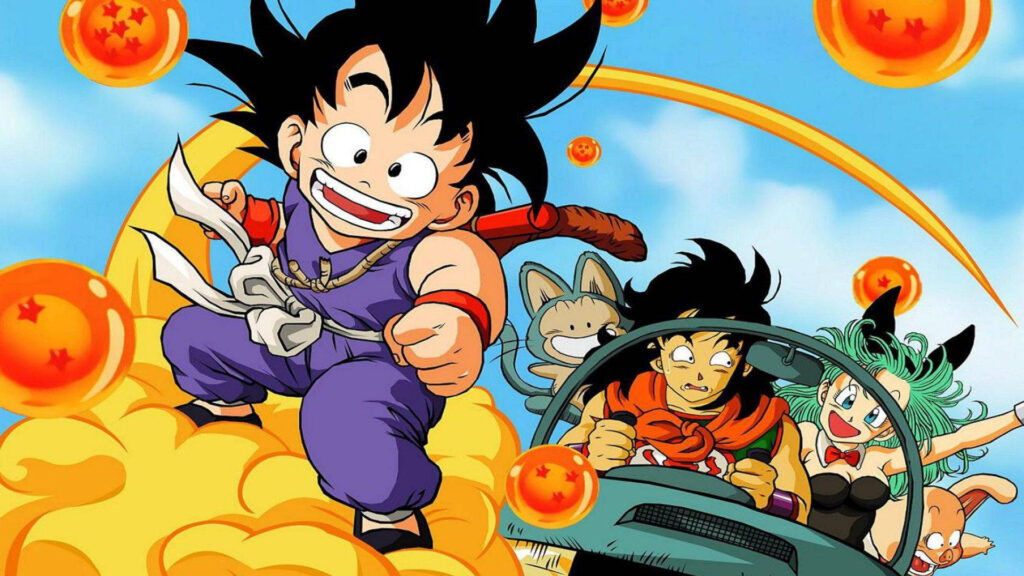
The Controversial Experiment: Dragon Ball GT
Dragon Ball GT premiered in 1996 as a bold continuation of the Dragon Ball Z legacy, yet it marked a significant departure from its predecessors. Unlike previous installments, it was created without Akira Toriyama’s direct involvement, relying instead on Toei Animation’s vision. The series took an adventurous turn, reintroducing Goku as a child due to a wish gone wrong and embarking on intergalactic journeys to recover the Black Star Dragon Balls. One of its standout features was the introduction of the Super Saiyan 4 transformation, which added a primal and visually striking evolution to Saiyan lore. However, its divergence from the manga’s tone and pacing left many fans divided.
Despite mixed reviews, Dragon Ball GT carved out a unique place in the franchise’s history and continues to resonate with a subset of fans. While some criticized its tonal shift and episodic storytelling, others appreciated its attempt to expand the Dragon Ball universe through creative narratives and fresh character designs. Elements like the Baby saga and the Shadow Dragon arc showcased innovative concepts, even if they didn’t achieve universal acclaim. Over time, the series has gained nostalgic value, standing as a reminder of the franchise’s ability to experiment and push boundaries, even if not every risk paid off.
A Modern Revival: Dragon Ball Kai
In 2009, Dragon Ball Kai debuted as a remastered version of the beloved Dragon Ball Z, aiming to bring the classic series to a new audience. Produced by Toei Animation, it featured enhanced visuals and improved sound quality to suit modern standards. One of its most significant changes was the removal of filler episodes, ensuring a tighter narrative that closely adhered to Akira Toriyama’s original manga. By condensing the story, Kai captured the essence of the original while delivering a faster-paced and more focused experience. Its introduction of new opening and ending sequences, coupled with a re-recorded voice cast, offered a fresh yet nostalgic take for long-time fans and newcomers alike.
The release of Dragon Ball Kai reignited global enthusiasm for the franchise, proving the enduring appeal of its timeless story. By modernizing Dragon Ball Z, it successfully bridged the gap between generations of fans, many of whom experienced the series for the first time through this streamlined adaptation. Its faithful retelling of pivotal sagas, including the battles against Vegeta, Frieza, and Cell, allowed viewers to rediscover the iconic moments that defined the series. The success of Kai cemented Dragon Ball as a cultural cornerstone, inspiring further developments like Dragon Ball Super and solidifying its place in anime history.
Dragon Ball Super: A New Chapter
In 2015, Dragon Ball Super marked the franchise’s triumphant return after an 18-year hiatus, reigniting fans’ passion for Goku’s journey. With Akira Toriyama’s active involvement, the series ventured into unexplored territory, introducing multiverse tournaments and complex new characters like Beerus, the God of Destruction. The introduction of the Super Saiyan God form, achieved through a divine ritual, set the stage for battles on a cosmic scale. These new story arcs blended action, humor, and emotional stakes, showcasing Dragon Ball‘s ability to evolve while staying true to its roots. The multiverse concept brought a fresh dynamic, featuring universes with their own unique warriors, including Jiren, a stoic powerhouse from Universe 11, who challenged Goku like never before.
Dragon Ball Super expanded its narrative scope, giving more depth to characters like Vegeta and Gohan while introducing powerful transformations like Ultra Instinct, which pushed Goku’s skills to their zenith. The series didn’t just focus on Goku’s growth but allowed supporting characters to shine, with Vegeta’s personal journey and determination standing out as a highlight. The Tournament of Power arc, with its high stakes and intense battles, became a fan favorite, solidifying the show’s global appeal. By blending new ideas with nostalgic callbacks, Dragon Ball Super demonstrated that the franchise remains a powerhouse in anime and pop culture, captivating both loyal followers and a new generation of viewers.
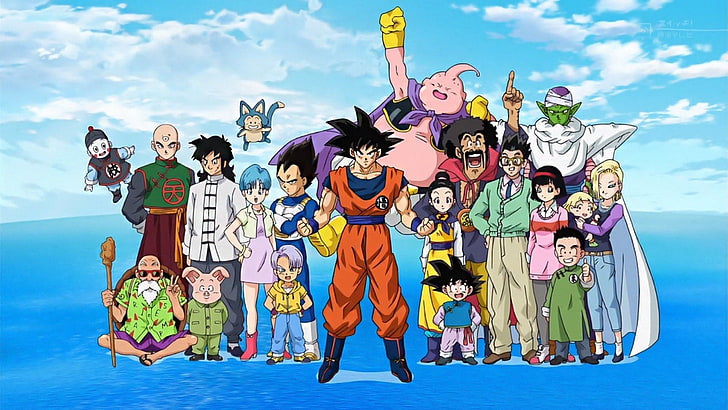
The Cultural Impact of Dragon Ball
Dragon Ball has transcended its status as an anime series to become a cultural phenomenon that has inspired generations. Renowned manga creators such as Masashi Kishimoto (Naruto) and Eiichiro Oda (One Piece) openly credit the series for shaping their own works. The unforgettable image of Goku unleashing the “Kamehameha” is more than a battle move—it’s a symbol of perseverance and pushing past limits, resonating with fans across the globe. The series’ themes of self-improvement and resilience have made it an enduring source of inspiration, influencing not only other creative works but also the personal philosophies of its followers. Its appeal lies in its ability to connect on both a narrative and emotional level, making Dragon Ball timeless.
Beyond the anime and manga industry, Dragon Ball has left its mark on various aspects of popular culture. Athletes have channeled Goku’s fighting spirit during competitions, often mimicking his iconic power-up poses as a nod to the series. Musicians incorporate references to Saiyans and Dragon Balls in their lyrics, blending the franchise into mainstream music. Even filmmakers have paid homage through stylistic choices and direct mentions. From merchandise sales to public screenings of episodes, Dragon Ball has proven its global reach. This cultural legacy underscores its role as not only a pioneer of shōnen storytelling but also a unifying force that continues to inspire and entertain audiences worldwide.
The Power of the Dragon Balls
The Dragon Balls are the heart of the Dragon Ball series, embodying themes of hope, ambition, and the complexities of desire. Scattered across the Earth, these seven mystical orbs summon Shenron, a wish-granting dragon, when united. Their ability to resurrect allies or fulfill extraordinary wishes has driven countless storylines, from reviving Goku’s friends after intense battles to altering the fate of entire planets. The Dragon Balls represent both the rewards and risks of ambition, as characters often face moral dilemmas over their use. This mythology adds depth to the franchise, making it more than just an action series and grounding it in thought-provoking themes about the consequences of our deepest desires.
Throughout the franchise, the Dragon Balls serve as a unifying thread, seamlessly connecting different arcs and characters. Whether in the original Dragon Ball, where Goku and Bulma embark on a lighthearted quest to find them, or in Dragon Ball Z and Dragon Ball Super, where their power becomes critical for reversing catastrophic events, the Dragon Balls remain pivotal. They’ve sparked conflicts, forged alliances, and even introduced new villains eager to exploit their power. The orbs’ influence extends beyond the narrative, symbolizing humanity’s innate desire for second chances and transformation. This timeless element ensures that the Dragon Balls remain central to the franchise’s enduring appeal.
The Influence of Akira Toriyama
Akira Toriyama’s creative genius was the driving force behind the conception and development of the Dragon Ball universe. Drawing inspiration from Chinese folklore, martial arts films, and his own vivid imagination, Toriyama crafted a narrative that seamlessly blended humor, action, and emotional depth. His characters, like the determined Goku and the witty Bulma, resonated with readers due to their relatability and growth throughout the series. The distinctive balance Toriyama achieved between lighthearted comedy and intense, action-packed moments set Dragon Ball apart from other manga and anime of its time. His ability to infuse timeless themes like perseverance, friendship, and redemption into the story ensured that the series would transcend cultural and generational boundaries.
Toriyama’s artistic style played a pivotal role in the global success of Dragon Ball, with its sharp lines, dynamic action sequences, and expressive character designs. These elements became a benchmark in the manga and anime industries, influencing creators worldwide. Beyond the story itself, Toriyama’s contributions extended to world-building, as he meticulously created a universe filled with rich lore and imaginative settings. Even decades later, his work continues to inspire modern series like One Piece and Naruto, as well as countless artists and storytellers. Toriyama’s dedication to his craft not only cemented his legacy as a pioneer of modern manga but also ensured that Dragon Ball remains an enduring symbol of creativity and innovation.
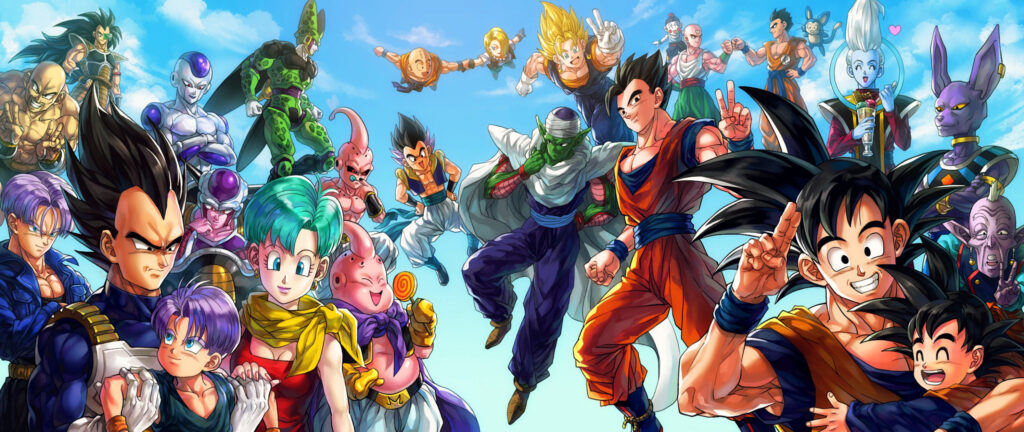
Merchandising and Video Games
Dragon Ball’s influence stretches far beyond its anime and manga roots, carving a massive footprint in the world of merchandising and video games. Collectible action figures, trading cards, and apparel featuring iconic characters like Goku and Vegeta have become staples for fans worldwide. These products not only celebrate the series’ rich lore but also serve as a gateway for new audiences to connect with its universe. The franchise’s global reach is evident in the enduring popularity of toys, posters, and limited-edition memorabilia, which have generated billions in revenue over the decades. Through these tangible connections, Dragon Ball solidified its status as a cultural phenomenon, transcending media formats to become a lasting presence in pop culture.
The video game industry has also played a critical role in expanding Dragon Ball’s legacy. Acclaimed titles such as Dragon Ball FighterZ received widespread praise for their fast-paced gameplay and faithful adaptation of the series’ intense battles. Similarly, immersive experiences like Dragon Ball Xenoverse and Dragon Ball Z: Kakarot allowed fans to step directly into Goku’s shoes, exploring iconic sagas in interactive ways. These games cater to both casual players and die-hard enthusiasts, keeping the franchise relevant across generations. By blending cutting-edge technology with the series’ trademark storytelling, Dragon Ball’s gaming ventures continue to captivate audiences, further solidifying its place in entertainment history.
Animated Films and Specials
Dragon Ball has cemented its legacy with over 20 animated films that add depth to its expansive universe. Movies like Dragon Ball Z: Broly and Dragon Ball Super: Super Hero have been celebrated for their compelling storylines and breathtaking animation. These films often explore themes beyond the main series, introducing characters like Broly and expanding on fan-favorites like Gohan and Piccolo. By blending rich narratives with high-octane action, the films deliver an experience that resonates with both long-time fans and newcomers. Their ability to explore untapped areas of the Dragon Ball lore while maintaining the franchise’s signature style exemplifies why they remain a cornerstone of its enduring popularity.
The cinematic success of these films underscores the franchise’s capacity to evolve while staying true to its roots. Dragon Ball Super: Super Hero, for instance, showcased advancements in animation, embracing a modern 3D style that brought battles to life in stunning detail. Meanwhile, the emotional depth of Broly reintroduced a classic villain with a new backstory that captivated audiences worldwide. These films not only entertain but also strengthen the bond between fans and the franchise, proving that Dragon Ball remains a cultural icon capable of adapting to the changing landscape of anime and film.
The Timeless Legacy
Since its debut as a manga in 1984, Dragon Ball has grown into a cultural cornerstone, captivating audiences across the globe. At its heart are themes of perseverance, friendship, and personal growth, universal concepts that transcend cultural barriers. These timeless values, combined with thrilling battles and heartfelt moments, have made the series a multi-generational favorite. From Goku’s humble beginnings to his battles against intergalactic foes, the franchise captures the spirit of adventure and the relentless pursuit of self-improvement, ensuring its relevance in the ever-evolving world of anime and manga.
The enduring appeal of Dragon Ball lies in its ability to adapt while honoring its roots. New projects like Dragon Ball Daima continue to expand the universe, introducing fresh narratives that resonate with both veteran fans and newcomers. This commitment to innovation while staying true to its core themes solidifies its place as a timeless story in pop culture. Decades after its inception, the franchise remains a powerful example of storytelling’s ability to inspire audiences, proving that the legacy of Dragon Ball will persist for generations to come.
How useful was this post?
Click on a star to rate it!
Average rating / 5. Vote count:
No votes so far! Be the first to rate this post.
Author
-
Meet Dr. Kendall Gregory, a highly accomplished professional with a remarkable academic background and a deep passion for empowering individuals through knowledge. Dr. Gregory’s educational journey began with a Bachelor of Science degree, followed by a Doctor of Chiropractic Medicine, focusing on diagnosing and treating musculoskeletal conditions. He further expanded his expertise with a Master's degree in Oriental Medicine, specializing in acupuncture and Chinese herbology, and a Master's degree in Health Care Administration, emphasizing his dedication to improving healthcare systems. Dr. Gregory combines his extensive knowledge and practical experience to provide comprehensive and integrative healthcare solutions. Through his writings, he aims to inspire individuals to take charge of their health and make informed decisions.
View all posts

